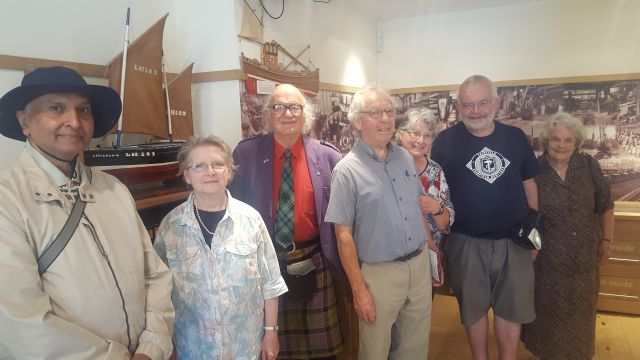
In 1988, concerned that the town’s rich heritage was being lost and forgotten, a group of Musselburgh residents formed a committee to redress that situation. Once established and with an office in the Old Town Hall building courtesy of East Lothian Council matters quickly took off. A small exhibition that proved successful and was curated which led to large, themed annual exhibitions being mounted which raised the profile with the public and enhanced the committee’s objective of creating a museum for the town.
During this time East Lothian Council decided to centralise all heritage of the county in Haddington but other towns objected wishing to retain control of their own heritage. However Lottery funding took forward creation of the John Gray Centre where facilities were created so that all documents and records pertaining to East Lothian could be lodged and safely stored, be curated and made available for research and posterity.
However with political changes the attitude became more sympathetic to local museums and councillors engaged a consultancy which made the case for reopening the museum in a worn-out building at North Berwick and creating a permanent one at Musselburgh. A sum of Council money was earmarked for that purpose and all was in place but for a suitable location in Musselburgh for a museum.
A former retail premises next to the Old Town Hall was proposed as suitable and after transfer from retail to non-retail purposes was completed work commenced to completely gut the building and strip all the floors and walls revealing some interesting original architectural features such as an old fireplace. Once done installation of lighting fitted with dimmers and of security shutters to museum standards was fitted together with a state of the art ambient control system the building was ready to be fitted out as a museum which was to be up to UK Museum standards.
A design company specialising in museums was engaged and together with the committee proceeded to plan the internal layout. Glass display cases at £10k apiece were procured and installed and to use the space to its maximum a number of glass topped drawers were fitted and with a fully equipped office a unisex,disable toilet and the premises being fully disabled friendly the museum was ready to open. However the intention had been to open in 2010, hence the logo MMX – Musselburgh Museum 2010 - but discovery of dry rot in the extension put back the official opening until 30 March 2011.
Since that time exhibitions on themes ranging from the Battle of Pinkie and the Racecourse’s 200th anniversary to the history of the town’s yacht and football clubs began to make good use of the display space, and only the lack of room for a cafe has prevented the Museum from going beyond its Visit Scotland four-star status.
The museum committee has a contract with East Lothian Council who own the premises and pay for all maintenance and upkeep, is staffed and run entirely by volunteers. Professional support is enjoyed from the Council Museums Service staff and the museum has built up such credibility such as to be described which has described as a jewel in the county’s crown.
Currently the Group aspires to see restoration of the Old Town Hall, Scotland’s oldest Tolbooth, and has recently received funding to undertake a feasibility study which will ensure the future of the building is secured. To take this vision forward will require a fully-costed business plan to form the basis of a bid to the Heritage Lottery Fund. That may take years to deliver.
Meanwhile this summer’s exhibition seeks to promote recognition of Musselburgh’s status as the Cradle of Golf – the first recorded game in the world was here in 1672 – it was an application from the Honourable Company of Leith Golfers in 1714 to form the first club that led to promulgation of the game’s rules. When the Honourable Company of Edinburgh Golfers decided in 1836 to move to Musselburgh because of encroachment on their original home, they started a movement that would transform not only the town but also golf itself. With them they brought the other Edinburgh clubs including the Royal Burgess, Bruntsfield and Warrender, and this concentration created work for local clubmakers, ballmakers and caddies who found employment in large numbers. From these master craftsmen came generations of innovators and talented players who kept golf alive until the coming of the latex-rubber gutta percha ball which democratised and revolutionised the game. Between 1850 and 1900 the number of golf courses soared across the world from just fifteen to three thousand.
As the links became overcrowded, Musselburgh began the process of emigration that took the game to the rest of the world. Its contribution to the history of golf has been underestimated, but the new exhibition open until 1 September celebrates the nineteenth-century glory days of the game’s establishment through the artefacts, trophies, art and literature of the time. It includes many items not seen in public in Scotland since 1860, such as a painting “A Summer Evening on the Musselburgh Links ; golfers” by Charles Lees which was recently sold at Bonhams.
A timeline round the walls of the Museum brings together historical, industrial and all other aspects of Musselburgh’s heritage from the earliest days until modern times, and recalls the origin of its name “The Honest Toun” in the tribute paid to the townsfolk by his successor Donald, Earl of Mar for their care of the dying Regent Thomas Randolph, Earl of Moray in July 1332. The objective to preserve and display all that rich history is what Musselburgh Museum is set to achieve and is doing so successfully.